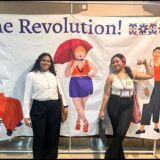Transforming Education with CSE
 School is a place where much of the powerful life’s battles are played out. By recognizing that most of the young people spend half of their day in the classrooms, they are one of the most important place for talk, learning and building skills. Schools are precisely the place where young people can be engaged in safe, critical talk about bodies, sexuality, relationships, disabilities, young LGBTs, abortion, gender equality and sexuality as a human right. Any effort to clarify and deepen the conceptual understanding of sexual rights as human rights is a deeply political project. It is political both because of the importance and sensitivity of the sexuality and sexual issues, and this work will help to refashion the relationship between the individuals and state.
School is a place where much of the powerful life’s battles are played out. By recognizing that most of the young people spend half of their day in the classrooms, they are one of the most important place for talk, learning and building skills. Schools are precisely the place where young people can be engaged in safe, critical talk about bodies, sexuality, relationships, disabilities, young LGBTs, abortion, gender equality and sexuality as a human right. Any effort to clarify and deepen the conceptual understanding of sexual rights as human rights is a deeply political project. It is political both because of the importance and sensitivity of the sexuality and sexual issues, and this work will help to refashion the relationship between the individuals and state.
Countries that have taken several initiatives in applying sexuality education and preventive programs had positive impact on adolescence life. Thus, such programs are vital in ensuring young people have the opportunity to explore the impact of rigid gender norms on their identities and behavior and to develop the knowledge, skills and attitudes which will enable them to form healthy relationships based on equality and respect. One should have the right to survive into adulthood and develop in the broadest sense of the word.
Comprehensive sexuality includes scientifically accurate information about human development, anatomy and reproductive health as well as information about contraceptives, childbirth and sexually transmitted infections including HIV. This education also includes discussions about family life, relationships, and culture and gender roles and also addresses human rights, gender equality and threats such as discriminations and sexual abuse. One aspects of sexual education that is often considered particularly challenging is the teaching of use of condoms as contraceptives and HIV preventions. Teenage girls who become pregnant leave school because of the inflexibility in the school structure and the lack of extra support and help.
In order to understand the sexual subjectivities more completely, educators need to reconstruct schooling as an empowering context in which we listen to and work with the meanings and experiences of sexuality revealed by the adolescence themselves. Sexuality is the central part of being human. Working on the gender equalities with the young people will contribute to preventing human rights violation and strengthen human rights education which can be a positive force driving towards the gender equality and empowerment. Accurate, easy to understand sexuality education enhances the quality of people’s lives by clarifying misconceptions and helping young people make informed choices. These include protection from harassment, infections and abuses. Sexuality education is a preventive tool against gender based violence, bullying and sexual abuse of children, through this sexuality education children develop awareness around their rights to be free from violence and to have healthy relationships.
Children with disabilities are one of the most marginalized groups by gender, social economic status, poverty, nationality, religion and sexual orientation. Inclusive education removes all such barriers and aim towards providing guidance to schools for reflection, planning and action for all children with special needs. The comprehensive and inclusive teaching and learning must be ensured to the greatest extent possible so that the differently abled children are given access to the education curriculum, participation in extracurricular activities, sports, culture, artistic, recreational and leisure activities. To achieve the goal of providing quality inclusive education, qualified personnel using teaching strategies responsive to different learning styles must be ensured alongside their non-differently abled peers for effective learning.
The lack of understanding in distinguishing inclusion from special education shows the need to seeing the child as the problem to seeing the school as the problem. Inclusive education is different from special education because it aims to bring together children with disabilities into regular classrooms with adjustments to enable participation. Not all disabilities can be prevented so it is important to strive to make the society inclusive so that all children have the opportunity to fully participate in evaluating and rethinking all social problems.
Certain perspectives are not represented in our course material. To speak to both sexes and work across cultures avoiding the social norms, it is crucial to engage ourselves in improving the need to sustain a whole developed child. Transforming education isn’t about the change for the sake of change, it is to strive our teachers develop values in their students to guide them towards the vision of creating a better world and to see what is possible beyond what just is.
This blog was written by Dolma Tshering Lhamo from Bhutan for a competition organized by our country advocacy network DRUK-Yisa and was awarded the first prize.






